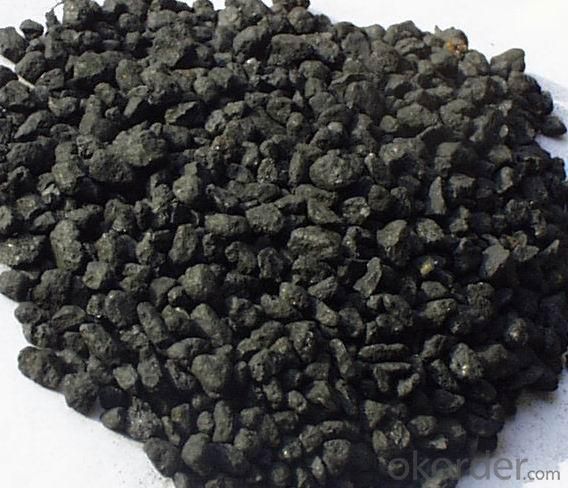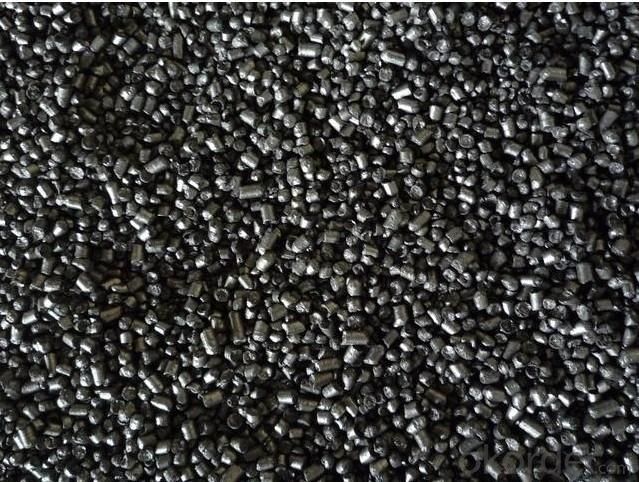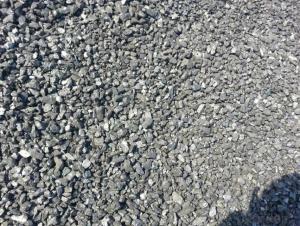Injection Carbon FC90-95 with Good and Stable Quality
- Loading Port:
- Tianjin
- Payment Terms:
- TT OR LC
- Min Order Qty:
- 20 m.t.
- Supply Capability:
- 5000 m.t./month
OKorder Service Pledge
OKorder Financial Service
You Might Also Like
Packaging & Delivery
Injection Carbon FC90-95 with Good and Stable Quality
25kgs/50kgs/1ton per bag or as buyer's request
Specifications
Injection Carbon FC90-95 with Good and Stable Quality
Calcined Anthracite
Fixed carbon: 90%-95%
S: 0.5% max
Size: 0-3. 3-5.3-15 or as request
Advantage and competitive of caclined anthracite:
Injection Carbon FC90-95 with Good and Stable Quality
1. strong supply capability
2. fast transportation
3. lower and reasonable price for your reference
4.low sulphur, low ash
5.fixed carbon:95% -90%
6..sulphur:lower than 0.3%
General Specification of Calcined Anthracite:
Injection Carbon FC90-95 with Good and Stable Quality
| FC | 95 | 94 | 93 | 92 | 90 |
| ASH | 4 | 5 | 6 | 6.5 | 8.5 |
| V.M. | 1 | 1 | 1 | 1.5 | 1.5 |
| S | 0.3 | 0.3 | 0.3 | 0.35 | 0.35 |
| MOISTURE | 0.5 | 0.5 | 0.5 | 0.5 | 0.5 |
Pictures
Injection Carbon FC90-95 with Good and Stable Quality



FAQ:
Injection Carbon FC90-95 with Good and Stable Quality
What can we do?
1.High quality and competitive price.
2.Timely delivery.
3.If any item you like. Please contact us.
Your sincere inquiries are typically answered within 24 hours.
- Q:What's the difference between an alkaline cell and a carbon cell?
- Alkaline batteries, also known as alkaline dry cells, alkaline manganese dioxide batteries and alkaline manganese batteries, are among the best in the range of zinc manganese batteries. The utility model is suitable for large discharge capacity and long time use. The internal resistance of the battery is low, so the current produced is larger than that of the general manganese battery, while the environmental friendly mercury content is only 0.025%. A carbon cell belongs to a primary battery in a chemical power supply and is a disposable battery. Because the chemical power unit has an electrolyte that is a non flowing paste, it is also called a dry cell, as opposed to a battery with a flowing electrolyte. Carbon battery is not only suitable for the flashlight, radios, tape recorders, cameras, semiconductor, electronic clocks, toys and other fields, but also for national defense, scientific research, telecommunication, navigation, aviation, medicine, etc. in the national economy.
- Q:How does carbon affect the taste of food and beverages?
- Carbon, in the form of activated charcoal or carbonation, can significantly affect the taste of food and beverages. Activated charcoal is known for its ability to absorb impurities and toxins, making it a popular ingredient in various food and drink products. When added to food and beverages, activated charcoal can help remove unpleasant odors and flavors, resulting in a cleaner and more enjoyable taste. In terms of carbonation, it is widely used in beverages to create fizziness and enhance the overall sensory experience. Carbon dioxide gas is dissolved in liquids under pressure, which creates bubbles when the pressure is released, giving the drink a refreshing and effervescent quality. This carbonation effect can add a tangy or slightly acidic taste to the beverage, which is often considered pleasant and invigorating. Moreover, carbonation can also influence the taste of food. For example, the carbonation present in beer or sparkling wine can help cut through the richness of certain dishes, balancing flavors and providing a more refreshing palate cleanse. Carbonation can also be added to certain foods, such as bread or pastry dough, helping them rise and creating a lighter texture. It is important to note that while carbon can enhance the taste of food and beverages, its impact can vary depending on the specific application and concentration used. Additionally, the taste of carbon in food and beverages is subjective, and some people may prefer non-carbonated or charcoal-free options. Ultimately, the use of carbon in culinary applications offers a wide range of possibilities for taste enhancement and sensory experiences.
- Q:They include a cementite, two cementite, three cementite, eutectic cementite and eutectoid cementite, and compare their temperature, composition and morphology
- Two: cementite in iron graphite phase, carbon content more than 0.77%, in A (Fe + Fe3C) two-phase region precipitation of Fe3C is two times the cementite formation temperature in the eutectic temperature (1148 DEG C) and eutectoid temperature (727 DEG C), morphology of the mesh is a typical carbon content. From 0.77% to 6.69% is the typical composition range.
- Q:How does carbon impact the availability of clean drinking water?
- The availability of clean drinking water can be significantly affected by carbon through various processes. One major way carbon impacts water quality is through the formation of acid rain caused by carbon dioxide emissions. When carbon dioxide combines with water in the atmosphere, it forms carbonic acid, which can be extremely harmful to water bodies. Freshwater sources can be devastated by acid rain, primarily caused by the release of carbon emissions from industrial activities and the burning of fossil fuels. This can result in a decrease in the pH level of lakes, rivers, and groundwater, making the water more acidic. The increased acidity can harm aquatic life, destroy ecosystems, and make water sources unsuitable for drinking, agriculture, or industrial use. Furthermore, carbon can affect the availability of clean drinking water through its role in climate change. Excessive carbon emissions contribute to the greenhouse effect, leading to rising global temperatures and changes in weather patterns. These changes can cause prolonged droughts and intense rainfall events, both of which can have negative effects on water availability and quality. Climate change-induced droughts can cause water scarcity as precipitation patterns become less predictable and water sources dry up. This can result in conflicts over limited water resources and force communities to rely on contaminated or unsafe water sources. Conversely, intense rainfall events caused by climate change can lead to flooding, overwhelming sewage systems and contaminating drinking water with pollutants and pathogens. Additionally, carbon emissions are linked to the degradation of natural ecosystems, such as forests and wetlands, which play a crucial role in water purification. Forests act as natural filters, absorbing carbon dioxide and releasing oxygen, while wetlands naturally filter and cleanse water. When these ecosystems are destroyed or degraded due to deforestation or drainage, the availability of clean drinking water is further compromised. To conclude, carbon emissions have a significant impact on the availability of clean drinking water. Acid rain formation, climate change-induced droughts and floods, and the degradation of natural ecosystems all contribute to water scarcity and contamination. It is crucial to protect and reduce carbon emissions in order to ensure the availability of clean drinking water for both present and future generations.
- Q:I just decoration, do not understand, JS run, please feel free to show.
- LED gold tube Yuba, tinghuo... Carbon fiber was a real fire last year
- Q:What is the structure of carbon-based polymers?
- The structure of carbon-based polymers involves long chains or networks of carbon atoms linked together by covalent bonds, forming the backbone of the polymer. These carbon atoms are typically bonded to other atoms such as hydrogen, oxygen, nitrogen, or halogens, which contribute to the overall properties and functionality of the polymer. The repeating units, or monomers, are connected through chemical reactions known as polymerization, resulting in a diverse range of structures and properties in carbon-based polymers.
- Q:Process for producing carbon fiber board
- The world produces two types of carbon fibers. One is the PAN based carbon fiber, which is made from polyacrylonitrile and the other is an asphalt based carbon fiber, which is distilled from coal, petroleum and synthetic asphalt into bitumen, and then polymerized into fibers.On the strength of carbon fiber PAN based carbon fiber to Youding asphalt base, so overwhelming absolute in the production of carbon fiber in the world.
- Q:How does carbon affect the formation of tornadoes?
- Carbon does not directly affect the formation of tornadoes. Tornadoes are primarily formed due to the interaction of warm, moist air with strong wind shear. However, carbon emissions and climate change can contribute to the overall increase in severe weather events, including tornadoes, by altering atmospheric conditions and increasing the energy available for storm development.
- Q:What are the impacts of carbon emissions on wildlife?
- Carbon emissions have a significant impact on wildlife and their ecosystems. One of the most direct impacts is through climate change caused by the release of greenhouse gases, primarily carbon dioxide, into the atmosphere. As carbon emissions contribute to the warming of the planet, it disrupts the delicate balance of ecosystems and affects biodiversity. One of the major consequences of climate change for wildlife is the alteration of habitats. Rising temperatures can lead to the loss of critical habitats such as coral reefs, mangroves, and polar ice caps, which are home to numerous species. This loss of habitat can result in the displacement or extinction of vulnerable species, disrupting entire food chains and ecological systems. Additionally, climate change can affect the timing and availability of resources for wildlife. Shifts in temperature and precipitation patterns can disrupt the timing of migration, breeding, and hibernation for many species. This can lead to mismatches between the availability of food sources and the needs of wildlife, ultimately impacting their survival and reproduction. Another impact of carbon emissions on wildlife is ocean acidification. When carbon dioxide dissolves in seawater, it forms carbonic acid, which lowers the pH of the oceans. Acidic waters can negatively affect marine organisms, particularly those with calcium carbonate shells or skeletons, such as corals, oysters, and certain types of plankton. This disruption in the marine food chain can have cascading effects on other marine species, including fish, birds, and marine mammals. Furthermore, carbon emissions contribute to air pollution, which can have direct impacts on wildlife. Pollutants such as nitrogen dioxide and sulfur dioxide can harm respiratory systems, impairing the health and reproductive success of animals. This can be particularly detrimental for species living in or near urban areas with high levels of pollution. In conclusion, carbon emissions have far-reaching impacts on wildlife. Climate change caused by carbon emissions disrupts habitats, alters resource availability, and contributes to ocean acidification. These changes can lead to the displacement or extinction of species, disrupt entire ecosystems, and impact the health and survival of wildlife. It is crucial to reduce carbon emissions and implement sustainable practices to mitigate these impacts and conserve biodiversity.
- Q:What is carbon dioxide?
- Carbon dioxide (CO2) is a colorless and odorless gas that consists of carbon and oxygen atoms. It is formed through the combustion of fossil fuels, as well as the natural processes of respiration and volcanic activity. Carbon dioxide plays a crucial role in the Earth's atmosphere as a greenhouse gas, trapping heat and contributing to the planet's overall temperature. While it occurs naturally, human activities such as burning of fossil fuels and deforestation have significantly increased its concentration in the atmosphere, leading to global warming and climate change. Carbon dioxide is also a byproduct of various industrial processes, such as cement production and power generation. Efforts to reduce carbon dioxide emissions are essential to mitigate the effects of climate change and maintain a sustainable environment.
1. Manufacturer Overview |
|
|---|---|
| Location | |
| Year Established | |
| Annual Output Value | |
| Main Markets | |
| Company Certifications | |
2. Manufacturer Certificates |
|
|---|---|
| a) Certification Name | |
| Range | |
| Reference | |
| Validity Period | |
3. Manufacturer Capability |
|
|---|---|
| a)Trade Capacity | |
| Nearest Port | |
| Export Percentage | |
| No.of Employees in Trade Department | |
| Language Spoken: | |
| b)Factory Information | |
| Factory Size: | |
| No. of Production Lines | |
| Contract Manufacturing | |
| Product Price Range | |
Send your message to us
Injection Carbon FC90-95 with Good and Stable Quality
- Loading Port:
- Tianjin
- Payment Terms:
- TT OR LC
- Min Order Qty:
- 20 m.t.
- Supply Capability:
- 5000 m.t./month
OKorder Service Pledge
OKorder Financial Service
Similar products
New products
Hot products































